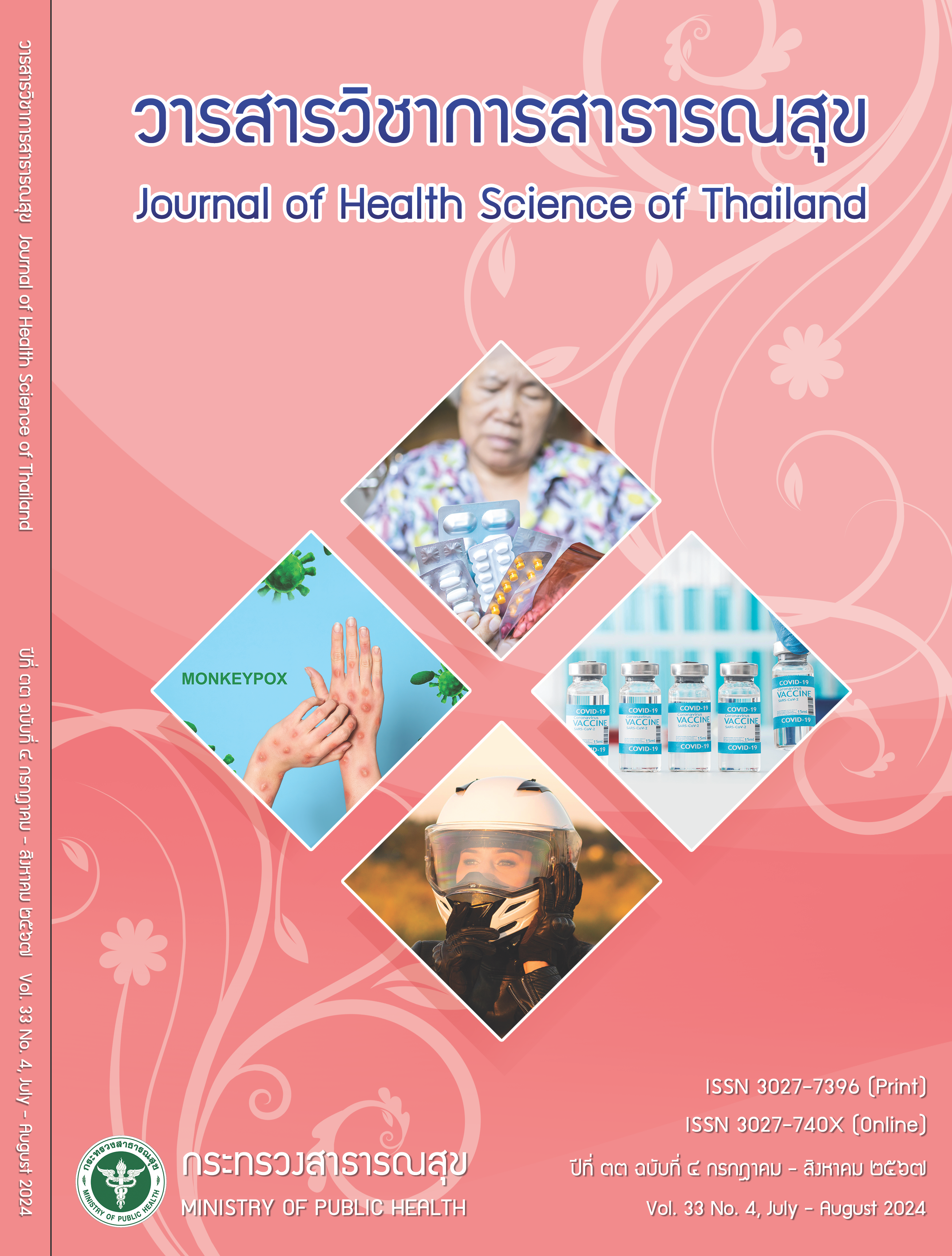Development of the To Be Number One Prevention and Resolve Drug Problems of a University in Maha Sarakham Province
Keywords:
develop a model, substance abuse, To Be Number One, prevention, youthAbstract
The objective of this study was to assess the factors related to drug prevention behaviors of students and develop a model for preventing and solving the drug problems through the To Be Number One project. The study was divided into 2 phases: phase 1 studied factors that were related to drug prevention behavior. The sample group was 450 students at a university in Maha Sarakham Province. The research instrument was divided into 7 parts with a reliability value of 0.88. The data were analyzed using multiple regression analysis. Phase 2 developed the operating model to prevent and solve the drug problems: the To Be Number One project using action research method. The target group was specifically selected, namely 58 people, using participatory planning with A-I-C technique and analyzing the data with content analysis. It was found that factors related to drug prevention behavior among students included personal factors, namely self-control, life skills, and awareness about drugs. and the social factor was supported from the university, which could be able to predict up to 32.8% of drug prevention behaviors. Phase 2 found that the model developed from operations to prevent and solve drug problems To Be Number One consited of 4 components: committee, funds, activities and strategies, of which the strategies developed were specified as the TAKASILA Model, whereby universities should determine measures to prevent and solve drug problems. Drug screening was performed at least 2 times per semester, interspersed with teaching and learning about drugs. This approach should help encourage students to have increased drug prevention behaviors.
Downloads
References
สำนักงานคณะกรรมการป้องกันและปราบปรามยาเสพติด. สรุุปการดำเนินการด้านการป้องกันยาเสพติด. เอกสารประกอบการประชุุมคณะกรรมการป้องกันและปราบปรามยาเสพติด ประจำปี 2564 [อินเทอร์เน็ต]. 2564 [สืบค้นเมื่อ 6 ก.พ. 2564]. แหล่งข้อมููล: https://www.oncb.go.th/EBookLibrary/annual%20report%202564.pdf
United Nations Office on Drugs and Crime. World Drug Report. [Internet]. 2021 [cited
Feb 18]. Available from https:// www.unodc.org/unodc/data-and-analysis/world-drug-report-2021.html
สำนักงานคณะกรรมการป้องกันและปราบปรามยาเสพติด. ระบบข้อมููลการบำบัดรักษาและฟื้นฟูผู้ติดยาเสพติดของประเทศประจำปี 2564 [อินเทอร์เน็ต]. 2564 [สืบค้นเมื่อ 24 มี.ค. 2564]. แหล่งข้อมููล: https://antidrugnew.moph. go.th/
ถนอมรัตน์ ประสิทธิเมตต์. สาเหตุุและกระบวนการติดยาบ้าในนักศึกษาอาชีวศึกษาศึกษา จังหวัดนครสวรรค์ [วิทยานิพนธ์์วิทยาศาสตรดุษฏีบัณฑิต]. ขอนแก่น: มหวิิทยาลัยขอนแก่น; 2561. 120 หน้า
สำนักงานเลขาการคณะกรรมการบำบัดฟืนฟูผู้ติดยาเสพติด. มาตรการป้องกันและปราบปรามยาเสพติด. กรุุงเทพมหานคร: สำนักนายกรัฐมนตรี; 2564.
กรมสุุขภาพจิต กระทรวงสาธารณสุุข. คู่มือการดำเนินงานโครงการรณรงค์และแก้ไขปัญหายาเสพติด To Be Number One ฉบับปรับปรุงใหม่ 2560 [อินเทอร์เน็ต]. 2564 [สืบค้นเมื่อ 4 ม.ค. 2564]. แหล่งข้อมููล: https://dmh-elibrary. org/items/show/216
คณะกรรมการดำเนิินงานป้องกัันและแก้้ไขปััญหายาเสพติิดมหาวิิทยาลััย. แนวทางการดำเนิินงานป้องกัันและแก้้ไขปัญหายาเสพติิดในมหาวิิทยาลััย: มหาสารคาม : มหาวิิทยาลััยราชภััฎ มหาสารคาม; 2564
สุรพล บุญทองสุุข. การดำเนินงานการป้องกันและแก้ไขปัญหายาเสพติดในสถาบันการศึกษาระดับอาชีวศึกษาและอุดมศึกษาในเขตกรุุงเทพมหานคร หลังประกาศสงครามของรัฐบาลเพื่อเอาชนะยาเสพติด. [วิทยานิพนธ์ปริญญาศึกษาศาสตรมหาบัณฑิต]. กรุุงเทพมหานคร: มหาวิทยาลัยเกษตรศาสตร์; 2564. 185 หน้า
Shorten A, Smith J. Mixed methods research: expanding the evidence base. Evid Based Nurs 2017;(3):74-5.
Yamane T. Statistics: an introductory analysis. 3 rd ed. New York: Harper and Row Publications; 1973.
Kemmis S, McTaggart R. The action research planner. 3rd ed. Geelong: Deakin University publisher; 2017.
Osborn AF. Applied Imagination AIC: principles and procedures of creative problem solving. New York: Charles Scribner’s Son; 1963.
WHO ASSIST Working Group. The Alcohol, Smoking and Substance Involvement Screening Test (ASSIST). development, reliability and feasibility. Addiction 2002; 97:1183-94.
Ehret PJ, Ghaidarov TM, LaBrie JW. Can you say no? Examining the relationship between
drinking refusal self-efficacy and protective behavior strategy use on alcohol outcomes. Addictive Behaviors 2013;38(4): 1898-904.
Oh H, Kim Y. Drinking behavior and drinking refusal self-efficacy in Korean college students. Psychological Reports 2014;115(3):872-83.
เจตน์สฤษฎิ์ สังขพันธ์. ปัจจัยที่มีอิทธิพลต่อพฤติกรรมเสี่ยงใช้สารเสพติดของเยาวชนไทยในอำเภอหาดใหญ่ จังหวัดสงขลา. วารสารศึกษาศาสตร์ มหาวิทยาลัยสงขลานครินทร์ วิทยาเขตปัตตานี 2563; 31(3):88-103.
Kumpfer KL, Turner CW. The social ecology model of adolescent substance abuse:
implications for revention. The Interational Journal of the Addictions 1990;25(4A): 435-63.
เกรียงศักดิ์ อุบลไทร. ปัจจัยทางจิตสังคมที่เกี่ยวข้องกับพฤติกรรมการป้องกันตนเองจากยาเสพติดของวัยรุ่น การประยุกต์ใช้การวิเคราะห์อนุุมาน. วารสารพฤติกรรมศาสตร์เพื่อการพัฒนา 2561;2(4):92-106.
วิมลสิริ บุญโญปกรณ์. การดำเนินงานตามนโนบายการป้องกันและแก้ไขปัญหายาเสพติดในสถานศึึกษาสัังกััด สำนัักงานคณะกรรมการอาชีวศึกษาในกรุงเทพมหานครไป สู่การปฏิบัติ. วารสารอิเล็กทรอนิกส์ทางการศึกษา 2564; 9(3):75-86.
อัจฉรา พงษ์โพธิ์. รูปแบบดำเนินการป้องกันนและแก้ไขปัญหายาเสพติดในมหาวิทยาลัยในสังกัดกรุุงเทพมหานคร. [วิทยานิพนธ์ปริญญาศึกษาศาสตรมหาบัณฑิต]. กรุงเทพมหานคร: มหาวิทยาลัยเกษตรศาสตร์; 2564. 148 หน้า.
Downloads
Published
How to Cite
Issue
Section
License
Copyright (c) 2024 Ministry of Public Health

This work is licensed under a Creative Commons Attribution-NonCommercial-NoDerivatives 4.0 International License.







